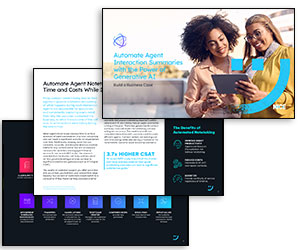What is an Auto Attendant?
An Auto Attendant (AA) is a system that routes calls based on choices selected by the caller from a menu. The options an AA presents are connected to keys on the customer’s DTMF phone; the system understands the customer’s choice by ‘listening’ to the tone of the key press.
AA systems have increasingly been used in conjunction with IVR since the 1990s, and the two terms are often used interchangeably. It is now common to hear options menus such as “say yes, or press 1”.
They are different pieces of technology, however; and while an AA simply routes calls, an IVR is a form of self-service portal that also responds to customer information. In simple terms, if an AA is a virtual receptionist, then an IVR is a virtual agent.
Benefits of an Automated Attendant
The primary purpose of an AA is to act as a switchboard, routing customers to the agent group best able to help them. This allows contact centres to quickly send customers to the right place without having a dedicated switchboard team or needing to advertise many different telephone numbers.
AAs can also offer callers the option to enter the extension of a specific individual and route the call directly to that person. Some have a limited ability to gather information from simple yes/no questions, although this has largely been overtaken by advances in IVR technology.
There are also secondary uses of AAs which have become regular business practice. Because going through an attendant is so much the norm for customers, contact centres use them to create an artificial delay that is acceptable to the customer. This creates more time to route the call, without significantly impacting customer satisfaction.
Additionally, some businesses employ AAs in situations where they aren’t strictly necessary. For example, numerous AA options often route to the same multi-skilled hunt group, but customer confidence is buoyed by the expectation that they are speaking to a specialist.
Automated Attendant Design
There are important design considerations when programming an AA. Where possible, AAs should establish how many questions they are going to ask, and present a clear route to an agent.
One of the most basic features is ensuring that information is prioritised so that the most popular options are offered first. Callers should also have the chance to hear options more than once. If no options are selected, callers are usually routed to a general enquiries group after a time delay.
Establishing caller benefit is important, as customers have traditionally had limited patience for these kinds of automated systems.
AA programming should also avoid cul de sacs. These are situations where the customer has no further options and is forced to hang up and start again. This sometimes occurs in AA options where information such as opening hours is delivered but no return option is presented.
Author: Jonty Pearce
Published On: 17th Feb 2017 - Last modified: 4th Apr 2022
Read more about - Definitions, Automation



































